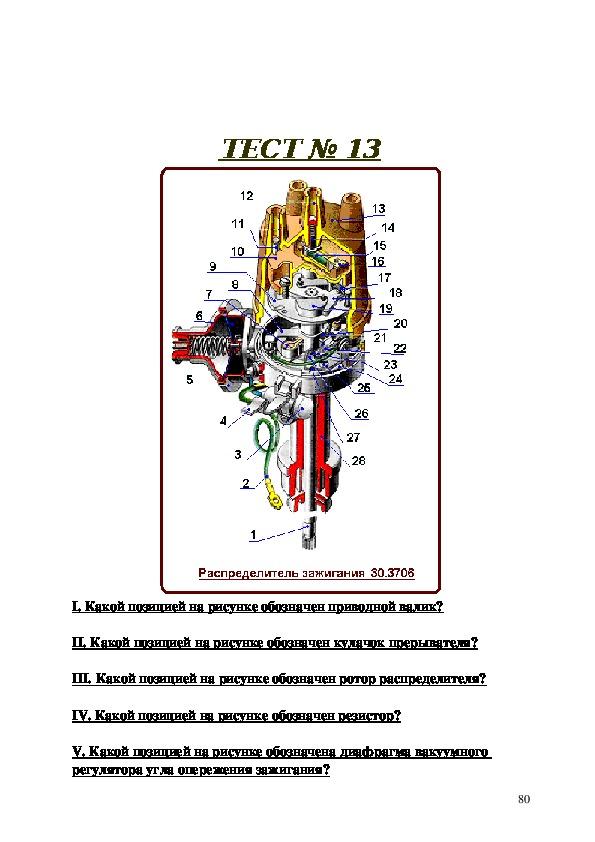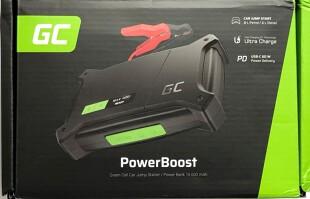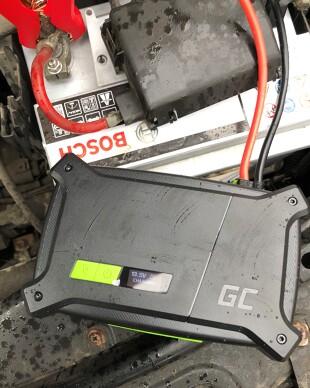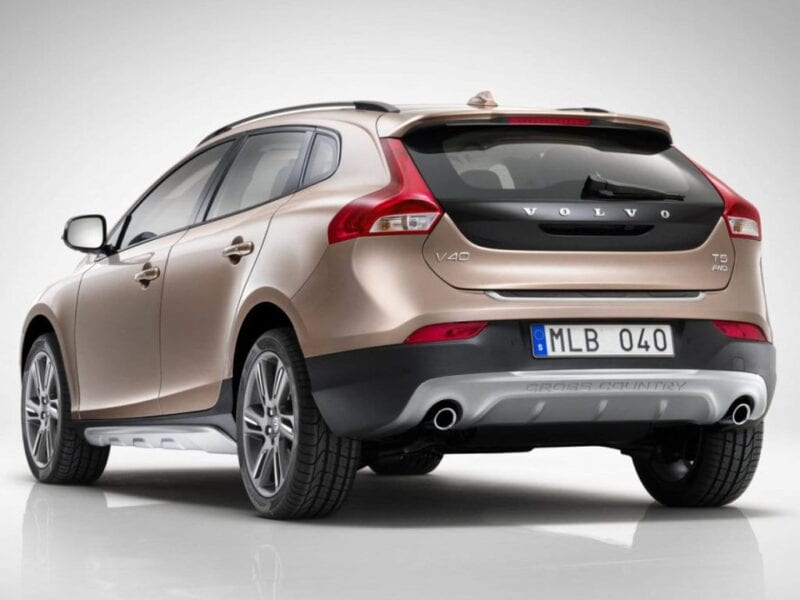
GC PowerBoost test. Quick, emergency "shot" of the car
Content
 At this time of the year, we often hear “tortured” autostarters in the morning, whose task is to start the vehicle. It's not a problem if you succeed in one move. Worse, when the starter does not even want to turn off. And then it appears ... That is, it would be nice if it appeared, because it will instantly solve the problem.
At this time of the year, we often hear “tortured” autostarters in the morning, whose task is to start the vehicle. It's not a problem if you succeed in one move. Worse, when the starter does not even want to turn off. And then it appears ... That is, it would be nice if it appeared, because it will instantly solve the problem.
Many drivers have trouble running a show on a winter morning at this time of year. All you need is an old battery that "does not provide power", a pantograph (parking lights, radio) left on at night or so-called "power leaks". They are almost common in older vehicles that either have a battery charging failure, or the electrical system is already so old that power is "lost" somewhere, or both.
Starting problems are also experienced by those who left their car “out in the open” for a long time, did not recharge the battery and one fine day decided to start the vehicle.
Emergency loading. How?
The easiest way out of this situation is the so-called "credit", i.e. Borrowing electricity from another vehicle using jumper cables. Many are already ready for this and carry cables in the trunk of a car in the autumn-winter period. Yes, just in case.
Simply borrowing electricity for some is not a problem, for others it is a “way through the torment” and a last resort. Firstly, we need to have cables, secondly, to find someone who will "loan" this electricity to us (and taxi drivers, if they agree, for a certain amount of money), thirdly, we do not always know how to connect cables, they are too short or damaged. In a word, a nightmare.
And here, too, an important note - most of the connecting cables on the market are low-quality products, poorly made from cheap materials that often burn out, get damaged or wear out. Their use can be very dangerous, so if we decide to buy them, we should always take a close look at how they were made.
Okay, if not connecting cables, then what?
GC PowerBoost test. Decision for years
 Small portable Power Bank devices called launchers (weaker) or boosters (more powerful) have been available on our market for some time and are used to start a car in an emergency, recharge a battery or power external devices.
Small portable Power Bank devices called launchers (weaker) or boosters (more powerful) have been available on our market for some time and are used to start a car in an emergency, recharge a battery or power external devices.
Car boosters are usually equipped with lithium-polymer batteries with a large capacity and high starting current. Their biggest advantage is that they can be discharged very deeply and quickly, and at the same time they do not have the so-called memory effect, due to which their service life is longer than that of other types of cells.
This also determined their choice for use in small car jump starters or chargers. With the small dimensions of the battery and the device itself, we get a powerful energy bank, which in an emergency we can use, among other things, to start a car with a discharged battery.
Another use of the booster is also the ability to recharge a discharged battery or the ability to power electronic devices via a USB socket (or sockets). Which can be especially useful in emergency situations while traveling.
One such device that has recently appeared on our market is the GC PowerBoost. Interestingly, the device, which is made in China (what is not made there today?), was developed by Green Cell, a Krakow-based company known for manufacturing and selling various types of batteries for electronic devices.
We decided to test how GC PowerBoost works in use.
GC PowerBoost test. One-Stop Solution
 In a rather small (dimensions: 187x121x47 mm) and lightweight case (750 g), we managed to place the elements and electronics of the device, which (according to the manufacturer) has a capacity of as much as 16 Ah (3,7 V), and the instantaneous current that we can get, up to 2000 A.
In a rather small (dimensions: 187x121x47 mm) and lightweight case (750 g), we managed to place the elements and electronics of the device, which (according to the manufacturer) has a capacity of as much as 16 Ah (3,7 V), and the instantaneous current that we can get, up to 2000 A.
The case is very durable and quite modern, resistant to weather conditions, and the color of the green inserts refers to the colors of the company logo.
GC PowerBoost is equipped with a convenient LCD OLED display, on which we can see the level of charge of the cells, as well as the current status of the device. In general, this rather simple solution is very convenient and is not often found in competitors.
See also: Can I register a police officer?
There are three USB connectors on one side (one USB-C for charging and power, and two USB-A for power). On the opposite side there is a socket for connecting a clamp to an EC5 car battery and a fairly bright (up to 500 lm) flashlight.
Placing the flashlight on the same side as the battery clip socket is a very smart decision, as it allows you to illuminate the area next to the battery when connected at night.
 The flashlight itself has four modes of operation - 100% light intensity, 50% light intensity, 10% light intensity, as well as a pulsed light mode (0,5 s - lighting, 0,5 s - off).
The flashlight itself has four modes of operation - 100% light intensity, 50% light intensity, 10% light intensity, as well as a pulsed light mode (0,5 s - lighting, 0,5 s - off).
After several days of testing the flashlight, we are sending the manufacturer two comments that can make this device even more functional.
First. maybe consider adding an orange LED that will provide better hazard indication with a pulsed light. And secondly, the rubber feet allow you to place the device “flat” so that the flashlight also shines flat. It may be possible to place such rubber stands on the shorter edge of the device, so that the flashlight will shine vertically, better illuminating the area, for example, when changing a wheel. We understand that stability may suffer, but we present this as our own contribution to the design.
Test GC PowerBoost. Mokarz
 After several days of waiting, we managed to detect a drop in temperature to minus 10 degrees. We decided to use it and run our tests.
After several days of waiting, we managed to detect a drop in temperature to minus 10 degrees. We decided to use it and run our tests.
We tested two battery models: Bosch S5 12 V / 63 Ah / 610 A and Varta C6 12 V / 52 Ah / 520 A, on two Volkswagen engines (petrol 1.8 / 125 hp and turbo diesel 1.6 / 90 hp). ), as well as on the Kii gasoline engine - 2.0 / 128 hp.
The batteries were discharged to a voltage of about 9 volts, at which the starter no longer wanted to start the engine.
Even with these dead batteries, the GC PowerBoost started all three drives with ease. At the same time, we tested each battery 3 times, with breaks of 1 minute.
What is important, GC PowerBoost can be used not only for emergency start of the car, but only after connecting the clamp to a discharged battery, it can serve as its charger, charging the cell with a current of about 3A.
The last resort is to try to start a heavily discharged battery that has been sitting in an unused car, for example, for several months. Such a test in GC PowerBoost is also possible, but ... it can only be carried out on 12V lead-acid batteries, with a voltage at the terminals below 5V. To do this, you need to switch to the "CAUTION" mode and carefully connect the entire device, since the protection systems against reverse switching and short circuit protection do not work in this mode.
Without such a dead battery, we simply connected the terminals directly to the GC PowerBoost and were not disappointed either.
GC PowerBoost test. Summary
 Our tests have fully demonstrated the suitability of GC PowerBoost in the event of a dead battery. The device is small, convenient, relatively light and can be used not only for emergency start of the car, but also for battery charging, powering portable devices or charging them. A very bright flashlight will also be useful.
Our tests have fully demonstrated the suitability of GC PowerBoost in the event of a dead battery. The device is small, convenient, relatively light and can be used not only for emergency start of the car, but also for battery charging, powering portable devices or charging them. A very bright flashlight will also be useful.
Convenient LCD display, clear (even at night) display, which is rare in devices of this class.
In a fairly short operation, we noted that it would be worth adding orange LEDs that can act as a warning light, as well as the possibility of placing the device on a shorter edge.
The crocodile clips for connecting the device to the battery clamp are also very well made. Although the teeth create a smaller area of contact between the clips and the alligator clips, they are placed quite tightly and the alligator clip itself is made of a relatively thick copper plate.
We also don't mind the length of connecting cables with alligator clips. In GC PowerBoost it is about 30 cm plus 10 cm for the length of the alligator clips. It's enough. You should also keep in mind that longer cables will be difficult to pack into a case.
And finally, big praise for the case. Thanks to this, everything can be elegantly packed and carried without fear that something will fall out on the trip.
The price, currently around PLN 750, is a moot point. There are many such devices on the market, even at half the price. However, it should be taken into account that their parameters, i.e. power, or peak inrush current, is usually much lower and therefore efficient use of the device can be problematic. The components used can also be (and probably are) of much lower quality.
In the case of the GC PowerBoost, we are paying for the quality, high performance, functionality and very good workmanship of a device that will work great both in and out of the car.
Options:
- Title: GC PowerBoost
- Model: CJSGC01
- Capacity: 16mAh / 000V / 3.7Wh
- Input (USB type C): 5 V / 3 A
- Outputs: 1 Type-USB C: 5V/3A
- 2 types - USB A: 5V / 2,4A (when using both outputs - 5V / 4A)
- Total output power: 80W
- Peak starting current: 2000A
- Compatibility: 12V petrol engines up to 4.0L, 12V diesel up to 2.5L.
- Resolution: 187x121x47mm
- Weight: 750 g
- Degree of protection: IP64
- Operating temperature: -20 to 50 degrees C.
- Charging temperature: 0 to 45 degrees C.
- Storage temperature: -20 to 50 degrees C.
Package includes:
- 1 external battery GC PowerBoost
- 1 clip with EC5 connector
- 1 USB-C to USB-C cable, length 120 cm
- 1 x EVA Type Protective Case
- 1 x User Manual
Read also: This is what Dacia Jogger looks like
